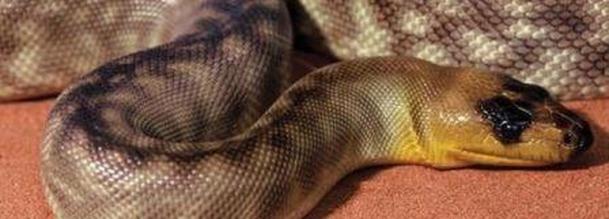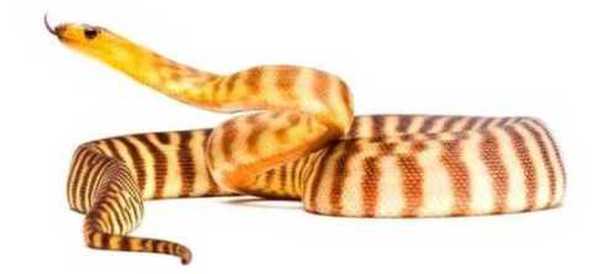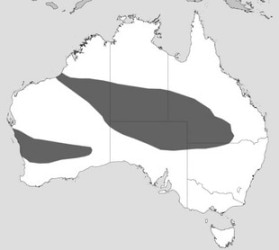Woma PythonAspidites ramsayi |

Custom Search
|
The woma python is found in arid and semi-arid habitats including scrublands, grasslands, woodlands and areas near the coast. From Western Australia into southern Northern Territory and northern South Australia through southern Queensland and northwestern New South Wales.
Its range is discontinuous and another population is found in southwest Australia extending from Shark Bay, along the coast and inland regions to the south and east. When they move across the hot surface of their desert habitats they lift their body off the ground and reach as far as possible before touching the ground to move forward. The woma python ground color ranges from golden brown, olive, gray or a rich red-brown, ringed with darker bands. The belly is cream to yellow, speckled with brown and pink blotches. Juvenile snakes exhibit a noticeable dark patch over the eyes, it may disappear as the snake grows but sometimes it persists into adulthood. They have small eyes in a narrow pointed head with no obvious neck separating it from the broad and flat body covered with smooth scales. The tail tapers down to a thin point. They can grow up to 8,5 feet (2,6 m) long, although the average length is about 4,5 feet (1,5 m).
Because of their appearance, they are occasionally mistaken for the highly venomous western brown (Pseudonaja nuchalis) commonly known as the gwardar. The species generic name, Aspidites, translates to "shield bearer" a reference to the large and symmetrically shaped head scales.
Their specific name, ramsayi, was given in honor of Australian zoologist Edward Pierson Ramsay. The species was described for the first time in 1882 by Sir William John Macleay an Australian politician, naturalist, zoologist, and herpetologist. The woma python and the black-headed python are the only 2 species of genus Aspidites an Australian genus of the family Pythonidae, also known as the pitless pythons. They lack the heat-sensing pits along the lips and front of the head characteristic of other python species. However they do possess an equivalent sensory organ located in their rostral scales. The woma python is largely a nocturnal snake but is occasionally seen basking in the day during mild weather. Usually in daytime they are found taking shelter in hollow logs, thick vegetation or under leaf debris. It also uses its head to dig burrows in the sand. The woma python is a very docile and easy to handle species and is highly in demand in the exotic pet trade. They are considered one of the hardiest and also more active pythons in captivity. A woma python can live up to 20 or 30 years in captivity. Diet / Feeding
Scientists knowledge of the woma python biology is very poor. We known that these non-venomous snakes feed mainly on reptiles like lizards but they do prey on other animals such as small mammals including the introduced rabbit or hare and birds. Womas ambush most of their prey in burrows, by either moving around and searching burrows, at night or waiting for prey to enter. Inside these burrows there isn't usually enough room to coil around their prey, and it will instead squash the prey against the walls to kill it. Because this technique is slower than constriction in killing the prey, many woma pythons are covered in scars, caused by rodents fighting to defend themselves. In captivity, they have been observed wiggling the end of the tail to lure prey. Reproduction Males will use their small cloacal spurs to stimulate females during mating season between May and August. The woma python is an oviparous snake species, and females lay around 5 to 20 eggs per clutch in September and October. The female remains coiled around their clutch until the eggs hatch, and may even ‘shiver’ if the eggs get too cold, using the muscular activity to generate heat. After an incubation period lasting 2 or 3 months, the young snakes hatch the female leaves the maternal burrow and the juvenile snakes are already independent. Conservation / Threats The woma python main threats include habitat loss due to land clearing for agriculture and thinning operations and predation by feral animals such as foxes and cats. In the southwest, many woma python populations have become critically endangered and there's hasn't been an authenticated record since the late 80's. They are also eaten by the king brown snake or mulga snake (Pseudechis australis), so much so that is has had a negative effect on the Adelaide Zoo reintroduction efforts in South Australia. The introduced offspring are very often killed by these venomous snakes before they can breed. The woma python is classified as Endangered on the IUCN Red List of Threatened Species. Is also considered a threatened species by Australian authorities, and receives special protection under Western Australia’s Wildlife Conservation Act. The species is also listed on CITES Appendix II.
|
Scientific classification |
© 2014 Snake Facts About Us | Privacy Policy | Contact





